A Review of the Motion Planning and Control Methods for Automated Vehicles
Abstract
1. Introduction
2. Automated Vehicle Motion Planning
2.1. Graph Search Algorithm
2.2. Curve Interpolation Algorithm
2.3. Sampling-Based Approach
2.4. Artificial Potential Field Method
2.5. Machine Learning Method
2.6. Numerical Optimization Algorithm
3. Tracking Control Methods for Automated Vehicles
3.1. PID Control
3.2. Robust Control
3.3. Sliding Mode Control
3.4. Fuzzy Control
3.5. Pure Pursuit Control
3.6. Linear Quadratic Regulator (LQR) Control
3.7. Model Predictive Control
4. Summary and Outlook
Author Contributions
Funding
Institutional Review Board Statement
Informed Consent Statement
Data Availability Statement
Conflicts of Interest
References
- Chen, H.; Xiong, G.; Gong, J.; Jiang, Y. Introduction to Driverless Cars; Beijing University of Technology Press: Beijing, China, 2014; pp. 15–17. [Google Scholar]
- González, D.; Pérez, J.; Milanés, V.; Nashashibi, F. A Review of Motion Planning Techniques for Automated Vehicles. IEEE Trans. Intell. Transp. Syst. 2016, 17, 1135–1145. [Google Scholar] [CrossRef]
- Kato, S.; Takeuchi, E.; Ishiguro, Y.; Takeda, K.; Hamada, T. An Open Approach to Autonomous Vehicles. IEEE Micro. 2015, 48, 60–68. [Google Scholar] [CrossRef]
- Plessen, M.G. Trajectory planning of automated vehicles in tube-like road segments. In Proceedings of the 2017 IEEE 20th International Conference on Intelligent Transportation Systems (ITSC), Yokohama, Japan, 16–19 October 2017; pp. 1–6. [Google Scholar]
- van Hoek, R.; Ploeg, J.; Nijmeijer, H. Cooperative Driving of Automated Vehicles Using B-Splines for Trajectory Planning. IEEE Trans. Intell. Veh. 2021, 6, 594–604. [Google Scholar] [CrossRef]
- Katrakazas, C.; Quddus, M.; Chen, W.H.; Deka, L. Real-time motion planning methods for autonomous on-road driving: State-of-the-art and future research directions. Transp. Res. Part C Emerg. Technol. 2015, 60, 416–442. [Google Scholar] [CrossRef]
- Liu, X.; Liang, J.; Zhang, H. Dynamic motion planner with trajectory optimisation for automated highway lane-changing driving. IET Intell. Transp. Syst. 2021, 14, 2133–2140. [Google Scholar] [CrossRef]
- Ji, J.; Khajepour, A.; Melek, W.W.; Huang, Y. Path planning and tracking for vehicle collision avoidance based on model predictive control with multiconstraints. IEEE Trans. Veh. Technol. 2017, 66, 952–964. [Google Scholar] [CrossRef]
- Hu, C.; Gao, H.; Guo, J.; Taghavifar, H.; Qin, Y.; Na, J.; Wei, C. Rise-based integrated motion control of autonomous ground vehicles with asymptotic prescribed performance. IEEE Trans. Syst. Man. Cybern. Syst. 2021, 51, 5336–5348. [Google Scholar] [CrossRef]
- Li, B.; Du, H.; Li, W. A potential field approach-based trajectory control for autonomous electric vehicles with in-wheel motors. IEEE Trans. Intell. Transp. Syst. 2016, 18, 2044–2055. [Google Scholar] [CrossRef]
- Selby, M.A. Intelligent Vehicle Motion Control. Doctoral Thesis, University of Leeds, Leeds, UK, 2003. [Google Scholar]
- Di, H.; Zhang, Y.; Wang, B.; Zhong, G.; Zhou, W. Review on the method and model of intelligent vehicles Lateral control. J. Chongqing Univ. Technol. 2021, 35, 71–81. [Google Scholar]
- Li, Y.; Ruan, J.; Li, C.; Fu, M. Longitudinal Motion Control of Intelligent Vehicle. China Mech. Eng. 2006, 42, 94–102. [Google Scholar] [CrossRef]
- Oommen, B.; Iyengar, S.; Rao, N.; Kashyap, R. Robot navigation in unknown terrains using learned visibility graphs. Part I: The disjoint convex obstacle case. IEEE J. Robot. Autom. 1987, 3, 672–681. [Google Scholar] [CrossRef]
- Canny, J. A Voronoi method for the piano-movers problem. In Proceedings of the 1985 IEEE International Conference on Robotics and Automation, St. Louis, MO, USA, 25–28 March 1985; pp. 530–535. [Google Scholar]
- Tian, C.; Liu, Y.; Feng, S.; Zhu, S. Complete Coverage of Known Space-Rectangular Decomposition. J. Eng. Mech. 2004, 40, 56–61. [Google Scholar] [CrossRef]
- Cormen, T.H.; Leiserson, C.E.; Rivest, R.L. Introduction to Algorithms; MIT: Cambridge, MA, USA, 2007. [Google Scholar]
- Zhu, D.; Sun, J. A New Algorithm Based on Dijkstra for Vehicle Path Planning Considering Intersection Attribute. IEEE Access 2021, 9, 19761–19775. [Google Scholar] [CrossRef]
- Liu, H.; Yang, J.; Lu, J.; Tang, Z.; Zhao, C.; Cheng, W. Research on Mobile Robots Motion Planning: A Survey. Strateg. Study CAE 2006, 8, 85–94. [Google Scholar]
- Wang, H.; Ma, Y.; Xie, Y. Guo, M. Mobile Robot Optimal Path Planning Based on Smoothing A* Algorithm. J. Tongji Univ. 2010, 38, 1647–1650. [Google Scholar]
- Min, H.; Xiong, X.; Wang, P.; Yu, Y. Autonomous driving path planning algorithm based on improved A* algorithm in unstructured environment. P. I. Mech. Eng. D-J. Aut. 2021, 235, 513–526. [Google Scholar] [CrossRef]
- Chao, Y.; Sun, W. Dynamic Path Modification for Multi-robot Path Planning. Mech. Sci. Technol. Aerosp. Eng. 2018, 37, 1483–1488. [Google Scholar]
- You, C.; Lu, J.; Filev, D.; Tsiotras, P. Autonomous planning and control for intelligent vehicles in traffic. IEEE Trans. Intell. Transp. Syst. 2019, 21, 2339–2349. [Google Scholar] [CrossRef]
- Chen, L.; Qin, D.; Xu, X.; Cai, Y.; Ju, X. A path and velocity planning method for lane changing collision avoidance of intelligent vehicle based on cubic 3-D Bezier curve. Adv. Eng. Softw. 2019, 132, 65–73. [Google Scholar] [CrossRef]
- Brezak, M.; Petrović, I. Real-time approximation of clothoids with bounded error for path planning applications. IEEE Trans. Robot. 2013, 30, 507–515. [Google Scholar] [CrossRef]
- Xu, W.; Wei, J.; Dolan, J.M.; Zhao, H.; Zha, H. A real-time motion planner with trajectory optimization for autonomous vehicles. In Proceedings of the 2012 IEEE International Conference on Robotics and Automation, Saint Paul, MN, USA, 14–18 May 2012; pp. 2061–2067. [Google Scholar]
- Glaser, S.; Vanholme, B.; Mammar, S.; Gruyer, D.; Nouvelière, L. Maneuver-based trajectory planning for highly autonomous vehicles on real road with traffic and driver interaction. IEEE Trans. Intell. Transp. Syst. 2010, 11, 589–606. [Google Scholar] [CrossRef]
- Petrov, P.; Nashashibi, F. Modeling and nonlinear adaptive control for autonomous vehicle overtaking. IEEE Trans. Intell. Transp. Syst. 2014, 15, 1643–1656. [Google Scholar] [CrossRef]
- Yang, D.; Zheng, S.; Wen, C.; Jin, P.J.; Ran, B. A dynamic lane-changing trajectory planning model for automated vehicles. Transp. Res. Part C. Emerg. Technol. 2018, 95, 228–247. [Google Scholar] [CrossRef]
- Kavraki, L.E.; Svestka, P.; Latombe, J.C.; Overmars, M.H. Probabilistic roadmaps for path planning in high-dimensional configuration spaces. IEEE Trans. Robot. Autom. 1996, 12, 566–580. [Google Scholar] [CrossRef]
- LaValle, S.M. Planning Algorithm; Cambridge University Press: Cambridge, UK, 2006; pp. 15–35. [Google Scholar]
- Paden, B.; Cap, M.; Yong, S.Z.; Yershov, D.; Frazzoli, E. A Survey of Motion Planning and Control Techniques for Self-driving Urban Vehicles. IEEE Trans. Intell. Veh. 2016, 1, 33–55. [Google Scholar] [CrossRef]
- Zhu, Z.; Xie, J.; Wang, Z. Global Dynamic Path Planning Based on Fusion of A* Algorithm and Dynamic Window Approach. In Proceedings of the 2019 Chinese Automation Congress (CAC), Hangzhou, China, 22–24 November 2019; pp. 5572–5576. [Google Scholar]
- Werling, M.; Ziegler, J.; Kammel, S. Optimal trajectory generation for dynamic street scenarios in a frenét frame. In Proceedings of the 2010 IEEE International Conference on Robotics and Automation, Anchorage, AK, USA, 3–7 May 2010; pp. 987–993. [Google Scholar]
- Ziegler, J.; Stiller, C. Spatiotemporal state lattices for fast trajectory planning in dynamic on-road driving scenarios. In Proceedings of the 2009 IEEE/RSJ International Conference on Intelligent Robots and Systems, St. Louis, MO, USA, 10–15 October 2009; pp. 1879–1884. [Google Scholar]
- Fox, D.; Burgard, W.; Thrun, S. The Dynamic Window Approach to Collision Avoidance. IEEE Robo. Autom. Mag. 2002, 4, 23–33. [Google Scholar] [CrossRef]
- Karaman, S.; Frazzoli, E. Optimal Kinodynamic Motion Planning using Incremental Sampling-based Methods. In Proceedings of the 49th IEEE Conference on Decision and Control (CDC), Atlanta, GA, USA, 15–17 December 2010; pp. 7681–7687. [Google Scholar]
- Liu, C.; Zhai, L.; Zhang, X. Research on local real-time obstacle avoidance path planning of unmanned vehicle based on improved artificial potential field method. In Proceedings of the 2022 6th CAA International Conference on Vehicular Control and Intelligence (CVCI), Nanjing, China, 28–30 October 2022; pp. 1–6. [Google Scholar]
- Zha, M.; Wang, Z.; Feng, J.; Feng, J.; Cao, X. Unmanned Vehicle Route Planning Based on Improved Artificial Potential Field Method. J. Phy. Conf. Ser. 2020, 1453, 012059. [Google Scholar] [CrossRef]
- Pan, Z.; Li, J.; Hu, K.; Zhu, H. Intelligent Vehicle Path Planning Based on Improved Artificial Potential Field Method. Appl. Mech. Mater. 2015, 742, 349–354. [Google Scholar] [CrossRef]
- Jurecki, R.S.; Stanczyk, T.L. Modelling Driver’s Behaviour While Avoiding Obstacles. Appl. Sci. 2023, 13, 616. [Google Scholar] [CrossRef]
- Cho, J.H.; Pae, D.S.; Lim, M.T.; Kang, T.K. A Real-Time Obstacle Avoidance Method for Autonomous Vehicles Using an Obstacle-Dependent Gaussian Potential Field. J. Adv. Transp. 2018, 2018, 1–15. [Google Scholar] [CrossRef]
- Wahid, N.; Zamzuri, H.; Abdul Rahman, M.A.; Kuroda, S.; Raksincharoensak, P. Study on potential field based motion planning and control for automated vehicle collision avoidance systems. In Proceedings of the 2017 IEEE International Conference on Mechatronics (ICM), Churchill, VIC, Australia, 13–15 February 2017; pp. 208–213. [Google Scholar]
- Wang, P.; Gao, S.; Li, L.; Sun, B.; Cheng, S. Obstacle avoidance path planning design for autonomous driving vehicles based on an improved artificial potential field algorithm. Energies 2019, 12, 2342. [Google Scholar] [CrossRef]
- Taghavifar, H. Neural Network Autoregressive with Exogenous Input Assisted Multi-Constraint Nonlinear Predictive Control of Autonomous Vehicles. IEEE Trans. Veh. Technol. 2019, 68, 6293–6304. [Google Scholar] [CrossRef]
- Chen, Z.; Huang, X. End-to-end learning for lane keeping of self-driving cars. In Proceedings of the 2017 IEEE Intelligent Vehicles Symposium (IV), Los Angeles, CA, USA, 11–14 June 2017; pp. 1856–1860. [Google Scholar]
- Nicola, F.; Fujimoto, Y. A LSTM Neural Network applied to Mobile Robots Path Planning. In Proceedings of the 2018 IEEE 16th International Conference on Industrial Informatics (INDIN), Porto, Portugal, 18–20 July 2018; pp. 349–354. [Google Scholar]
- Konar, A.; Goswami Chakraborty, S.; Singh, S.J.; Jain, L.C.; Nagar, A.K. A Deterministic Improved Q-Learning for Path Planning of a Mobile Robot. IEEE Trans. Syst. Man Cyber. Syst. 2013, 43, 1141–1153. [Google Scholar] [CrossRef]
- Zhu, M.; Wang, X.; Wang, Y. Human-like autonomous car-following model with deep reinforcement learning. Transp. Res. Part C. Emerg. Technol. 2018, 97, 348–368. [Google Scholar] [CrossRef]
- Lefevre, S.; Carvalho, A.; Borrelli, F. A Learning-Based Framework for Velocity Control in Autonomous Driving. IEEE Trans. Autom. Sci. Eng. 2016, 13, 32–42. [Google Scholar] [CrossRef]
- Hu, X.; Chen, L.; Tang, B.; Cao, D.; He, H. Dynamic path planning for autonomous driving on various roads with avoidance of static and moving obstacles. Mech. Syst. Signal Process 2018, 100, 482–500. [Google Scholar] [CrossRef]
- Dixit, S.; Fallah, S.; Montanaro, U.; Dianati, M.; Stevens, A.; Mccullough, F.; Mouzakitis, A. Trajectory planning and tracking for autonomous overtaking: State-of-the-art and prospects. Annu. Rev. Control 2018, 45, 76–86. [Google Scholar] [CrossRef]
- Rosolia, U.; Bruyne, S.D.; Alleyne, A.G. Autonomous Vehicle Control: A Nonconvex Approach for Obstacle Avoidance. IEEE Trans. Control Syst. Technol. 2017, 25, 469–484. [Google Scholar] [CrossRef]
- Zuo, Z.; Yang, X.; Zhang, Z.; Wang, Y. Lane-Associated MPC Path Planning for Autonomous Vehicles. In Proceedings of the 2019 Chinese Control Conference (CCC), Guangzhou, China, 27–30 July 2019; pp. 6627–6632. [Google Scholar]
- Li, X.; Sun, Z.; Cao, D.; He, Z.; Zhu, Q. Real-time trajectory planning for autonomous urban driving: Framework, algorithms, and verifications. IEEE ASME Trans. Mechatron. 2015, 21, 740–753. [Google Scholar] [CrossRef]
- Funke, J.; Brown, M.; Erlien, S.M.; Gerdes, J.C. Collision avoidance and stabilization for autonomous vehicles in emergency scenarios. IEEE Trans. Control Syst. Technol. 2016, 25, 1204–1216. [Google Scholar] [CrossRef]
- Sun, L.; Ma, J.; Yang, B. Fuzzy PID Design of Vehicle Attitude Control Systems. In Proceedings of the 2020 Chinese Control And Decision Conference (CCDC), Hefei, China, 22–24 August 2020; pp. 1826–1830. [Google Scholar]
- Cao, J.; Cao, B.; Chen, W.; Xu, P. Neural Network Self-adaptive PID Control for Driving and Regenerative Braking of Electric Vehicle. In Proceedings of the 2007 IEEE International Conference on Automation and Logistics, Jinan, China, 18–21 August 2007; pp. 2029–2034. [Google Scholar]
- Zuo, S.; Song, Y.; Wang, L.; Zhou, Z. Neuron-Adaptive PID Based Speed Control of SCSG Wind Turbine System. Abstr. Appl. Analy. 2014, 2014, 1–10. [Google Scholar] [CrossRef]
- Marino, R.; Scalzi, S.; Netto, M. Nested PID steering control for lane keeping in autonomous vehicles. Control Eng. Pract. 2011, 19, 1459–1467. [Google Scholar] [CrossRef]
- Li, B. Research on Lateral Dynamics Control of Four-Wheel Active Steering Vehicles. Doctoral Thesis, Shanghai Jiao Tong University, Shanghai, China, 2010. [Google Scholar]
- Tan, H.S.; Guldner, J.; Patwardhan, S.; Chen, C.; Bouglerl, B. Development of an automated steering vehicle based on roadway magnets—A case study of mechatronic system design. IEEE ASME Trans. Mechatron. 1999, 4, 258–272. [Google Scholar]
- Tai, M.; Hingwe, P.; Tomizuka, M. Modeling and control of steering system of heavy vehicles for automated highway systems. IEEE ASME Trans. Mechatron. 2004, 9, 609–618. [Google Scholar] [CrossRef]
- Kayacan, E.; Ramon, H.; Saeys, W. Robust trajectory tracking error-based model predictive control for unmanned ground vehicles. IEEE ASME Trans. Mechatron. 2016, 21, 806–814. [Google Scholar] [CrossRef]
- Jin, X.; Yu, Z.; Yin, G.; Wang, J. Improving Vehicle Handling Stability Based on Combined AFS and DYC System via Robust Takagi-Sugeno Fuzzy Control. IEEE Trans. Intell. Transp. Syst. 2018, 19, 2696–2707. [Google Scholar] [CrossRef]
- Hu, J.; Wang, Y.; Fujimoto, H.; Hori, Y. Robust yaw stability control for in-wheel motor electric vehicles. IEEE ASME. Trans. Mechatron. 2017, 22, 1360–1370. [Google Scholar] [CrossRef]
- Feng, Z.; Jiang, H.; Wei, Q.; Hong, Y.; Oluwaleke Ojo, A. Model-free adaptive sliding mode control for intelligent vehicle longitudinal dynamics. Adv. Mech. Eng. 2022, 14, 16878132221110131. [Google Scholar]
- Zhao, X.; Liu, H.; Xiong, G.; Gong, J.; Chen, H. Method of Parameter Selection for Automatic Steering Sliding Mode Control. Trans. Beijing Inst. Technol. 2011, 31, 1174–1178. [Google Scholar]
- Jiang, L.; Wu, Z. Sliding Mode Control for Intelligent Vehicle Trajectory Tracking Based on Reaching Law. Trans. Chin. Soc. Agric. Mach. 2018, 49, 381–386. [Google Scholar]
- Wang, J.; Steiber, J.; Surampudi, B. Autonomous ground vehicle control system for high-speed and safe operation. Int. J. Veh. Auton. Syst. 2009, 7, 18–35. [Google Scholar] [CrossRef]
- Wang, J.; Chen, W.; Wang, T.; Wang, M.; Xiao, L. Vision Guided Intelligent Vehicle Lateral Control Based on Desired Yaw Rate. J. Mech. Eng. 2012, 48, 108–115. [Google Scholar] [CrossRef]
- Shi, W.; Sun, T.; Ma, Y.; Chen, Y. Adaptive fuzzy path following control for a nonholonomic mobile robots. In Proceedings of the 10th World Congress on Intelligent Control and Automation, Beijing, China, 6–8 July 2012; pp. 204–208. [Google Scholar]
- He, F.; Huang, Q. Time-Optimal Trajectory Planning of 6-DOF Manipulator Based on Fuzzy Control. Actuators 2022, 11, 332. [Google Scholar] [CrossRef]
- Fang, Y.; Wang, S.; Bi, Q.; Wu, G.; Guan, W.; Wang, Y.; Yan, C. Research on Path Planning and Trajectory Tracking of an Unmanned Electric Shovel Based on Improved APF and Preview Deviation Fuzzy Control. Machines 2022, 10, 707. [Google Scholar] [CrossRef]
- Silva, M.; Garrote, L.; Moita, F.; Martins, M.; Nunes, U. Autonomous electric vehicle: Steering and path-following control systems. In Proceedings of the 16th IEEE Mediterranean Electrotechnical Conference, Yasmine Hammamet, Tunisia, 25–28 March 2012; pp. 442–445. [Google Scholar]
- Xiong, L.; Yang, X.; Zhuo, G.; Leng, B.; Zhang, R. Review on Motion Control of Autonomous Vehicles. J. Mech. Eng. 2020, 56, 127–143. [Google Scholar]
- Masmoudi, M.S.; Krichen, N.; Masmoudi, M.; Derbel, N. Fuzzy logic controllers design for omnidirectional mobile robot navigation. Appl. Soft Comput. 2016, 49, 901–919. [Google Scholar] [CrossRef]
- Tang, C.; Zhao, Y.; Zhao, Y.; Zhou, S. Research on the Trajectory Tracking Control Method of Intelligent Vehicles. J. Northeast Univ. 2020, 41, 1297–1303. [Google Scholar]
- Diao, Q.; Zhang, Y.; Zhu, L. A Lateral and Longitudinal Fuzzy Control of Intelligent Vehicles with Double Preview Points for Large Curvature Roads. China Mech. Eng. 2019, 30, 1445–1452. [Google Scholar]
- Guo, J.; Hu, P.; Li, L.; Wang, R.; Guo, L. Mixed Lateral Controller Design for Intelligent Vehicle Based on Switching. Trans. Chin. Soc. Agric. Mach. 2012, 43, 1–5. [Google Scholar]
- Liu, Y.; Shi, G.; Chen, Y.; Shi, L. Fuzzy Path Following Control Method Based on Pure Pursuit Model. Mach. Des. Res. 2022, 38, 136–140+157. [Google Scholar]
- Huang, Y.; Luo, W.; Lan, H. Adaptive Pre-Aim Control of Driverless Vehicle Path Tracking Based on a SSA-BP Neural Network. World Electr. Veh. J. 2022, 13, 55. [Google Scholar] [CrossRef]
- Ming, T. Research on Trajectory Tracking Control for Intelligent Vehicles. Master Thesis, Jilin University, Jilin, China, 2016. [Google Scholar]
- Wang, H.; Chen, X.; Chen, Y.; Li, B.; Miao, Z. Trajectory Tracking and Speed Control of Cleaning Vehicle Based on Improved Pure Pursuit Algorithm. In Proceedings of the 2019 Chinese Control Conference (CCC), Guangzhou, China, 27–30 July 2019; pp. 4348–4353. [Google Scholar]
- Urmson, C.; Ragusa, C.; Ray, D.; Anhalt, J.; Bartz, D.; Galatail, T.; Gutierrez, A.; Joshnston, J.; Harbaugh, S.; Messner, W.; et al. A robust approach to high-speed navigation for unrehearsed desert terrain. J. Field Robot. 2006, 23, 467–508. [Google Scholar] [CrossRef]
- Guo, K.; Guan, H. Modelling of Driver/Vehicle Directional Control System. Veh. Syst. Dyn. 1993, 22, 141–184. [Google Scholar] [CrossRef]
- Symonds, P.; Sharp, R.S.; Casanova, D. A Mathematical Model for Driver Steering Control, with Design, Tuning and Performance Results. Veh. Syst. Dyn. 2000, 33, 289–326. [Google Scholar] [CrossRef]
- Rucco, A.; Notarstefano, G.; Hauser, J. An Efficient Minimum-Time Trajectory Generation Strategy for Two-Track Car Vehicles. IEEE Trans. Control Syst. Technol. 2015, 23, 1505–1519. [Google Scholar] [CrossRef]
- Gong, D.; Pan, Q.; Zuo, G.; Li, X. LQR control for a self-balancing unicycle robot on Inclined Plane. J. Syst. Des. Dyn. 2012, 6, 685–699. [Google Scholar]
- Zhong, J. A Comparative Study of LQR and MPC Controllers in the Application of Parking Path Tracking. Auto Time 2020, 39, 21–22. [Google Scholar]
- Wu, L.; Zhou, R.; Bao, J.; Yang, G.; Sun, F. Vehicle Stability Analysis under Extreme Operating Conditions Based on LQR Control. Sensors 2022, 22, 9791. [Google Scholar] [CrossRef]
- Yan, Y.; LI, M. Path tracking of agricultural vehicles based on single neuron adaptive PID control. Mach. Des. Manuf. 2020, 356, 228–231+235. [Google Scholar]
- Wang, Y.; Luo, J.; Luo, X.; Yang, X.; Yu, F. Design of LQR controllers of active suspensions based on improved artificial bee colony algorithm. Noise Vib. Control 2021, 41, 61–66. [Google Scholar]
- Sun, H.; Li, Y.; Zhao, L.; Wang, Y.; Wang, Y.; Zhao, J. Research on vehicle trajectory tracking control based on optimal slip ratio. Automob. Appl. Technol. 2020, 312, 61–64. [Google Scholar]
- Wang, R.; Zhang, R.; Chu, J.; You, F. Optimizing design and quality analysis for CyberCar controller. Trans. Chin. Soc. Agric. Mach. 2007, 38, 22–25. [Google Scholar]
- Ni, L.; Lin, F.; Wang, K. Research on path-following control of intelligent vehicles based on preview model. J. Chongqing Univ. Technol. 2017, 31, 27–33. [Google Scholar]
- Althoff, M.; Dolan, J.M. Online Verification of Automated Road Vehicles Using Reachability Analysis. IEEE Trans. Robot. 2017, 30, 903–918. [Google Scholar] [CrossRef]
- Coppola, A.; Lui, D.G.; Petrillo, A.; Santini, S. Eco-Driving Control Architecture for Platoons of Uncertain Heterogeneous Nonlinear Connected Autonomous Electric Vehicles. IEEE Trans. Intell. Transp. Syst. 2022, 23, 24220–24234. [Google Scholar] [CrossRef]
- Batkovic, I.; Zanon, M.; Falcone, P. AI-Enabled Technologies for Autonomous and Connected Vehicles; Springer International Publishing: Cham, Switzerland, 2022; pp. 255–282. [Google Scholar]
- Luo, Y.; Chen, T.; LI, K. Nonlinear model predictive cruise control of hybrid electric vehicle. J. Mech. Eng. 2015, 51, 11–18. [Google Scholar] [CrossRef]
- Zhang, L.; Wu, G.; Guo, X. Path Tracking Using linear time-varying model predictive control for autonomous vehicle. J. Tongji Univ. 2016, 44, 1595–1603. [Google Scholar]
- Hu, J.; Hu, Y.; Chen, H.; Liu, K. Research on trajectory tracking of unmanned tracked vehicles based on model predictive control. Acta Armamentarii. 2019, 40, 456–463. [Google Scholar]
- Li, S.; Wang, J.; Li, K. Stability method for predictive control system of soft constrained linear model. J. Tsinghua Univ. Sci. Technol. 2010, 50, 1148–1152. [Google Scholar]
- Xiong, G.; Lu, H.; Guo, K.; Chen, H. Research on trajectory prediction of tracked vehicles based on real time slip estimation. Acta Armamentarii. 2017, 38, 600–607. [Google Scholar]
- Li, S.; Jia, Z.; Li, K.; Cheng, B. Fast online computation of a model predictive controller and its application to fuel economy: Oriented adaptive cruise control. IEEE Trans. Intell. Transp. Syst. 2015, 16, 1199–1209. [Google Scholar] [CrossRef]
- Rafaila, R.C.; Livint, G. Nonlinear model predictive control of autonomous vehicle steering. In Proceedings of the 19th International Conference on System Theory, Control and Computing (ICSTCC), Cheile Gradistei, Romania, 14–16 October 2015; pp. 466–471. [Google Scholar]
- Wang, Y.; Cai, Y.; Chen, L.; Wang, H.; He, Y. Design of Intelligent and Connected Vehicle Path Tracking Controller Based on Model Predictive Control. J. Mech. Eng. 2019, 55, 136–144. [Google Scholar] [CrossRef]
- Jiang, H.; Wei, Q.; Li, A.; Tang, B.; Geng, G. An operating condition adaptive path tracking control method for intelligent vehicle. J. Chongqing Univ. Technol. 2022, 36, 1–11. [Google Scholar]
- Yoshimoto, K.I.; Ogawa, H.; Kubota, H. Course tracking control algorithm using visual information. Veh. Syst. Dyn. 1997, 28, 385–398. [Google Scholar] [CrossRef]
- Van Nguyen, L.; Huy Dao, D. Iterative Learning Control For Autonomous Driving Vehicles. In Proceedings of the International Conference on Advanced Technologies for Communications (ATC), Hanoi, Vietnam, 17–19 October 2019; pp. 243–247. [Google Scholar]
- Son, T.D.; Nguyen, L.; Van Der Auweraer, H. Learning Control Applications for Autonomous Driving in Extreme Maneuver Scenarios. In Proceedings of the 21st International Conference on Control, Automation and Systems (ICCAS), Jeju, Republic of Korea, 12–15 October 2021; pp. 974–979. [Google Scholar]
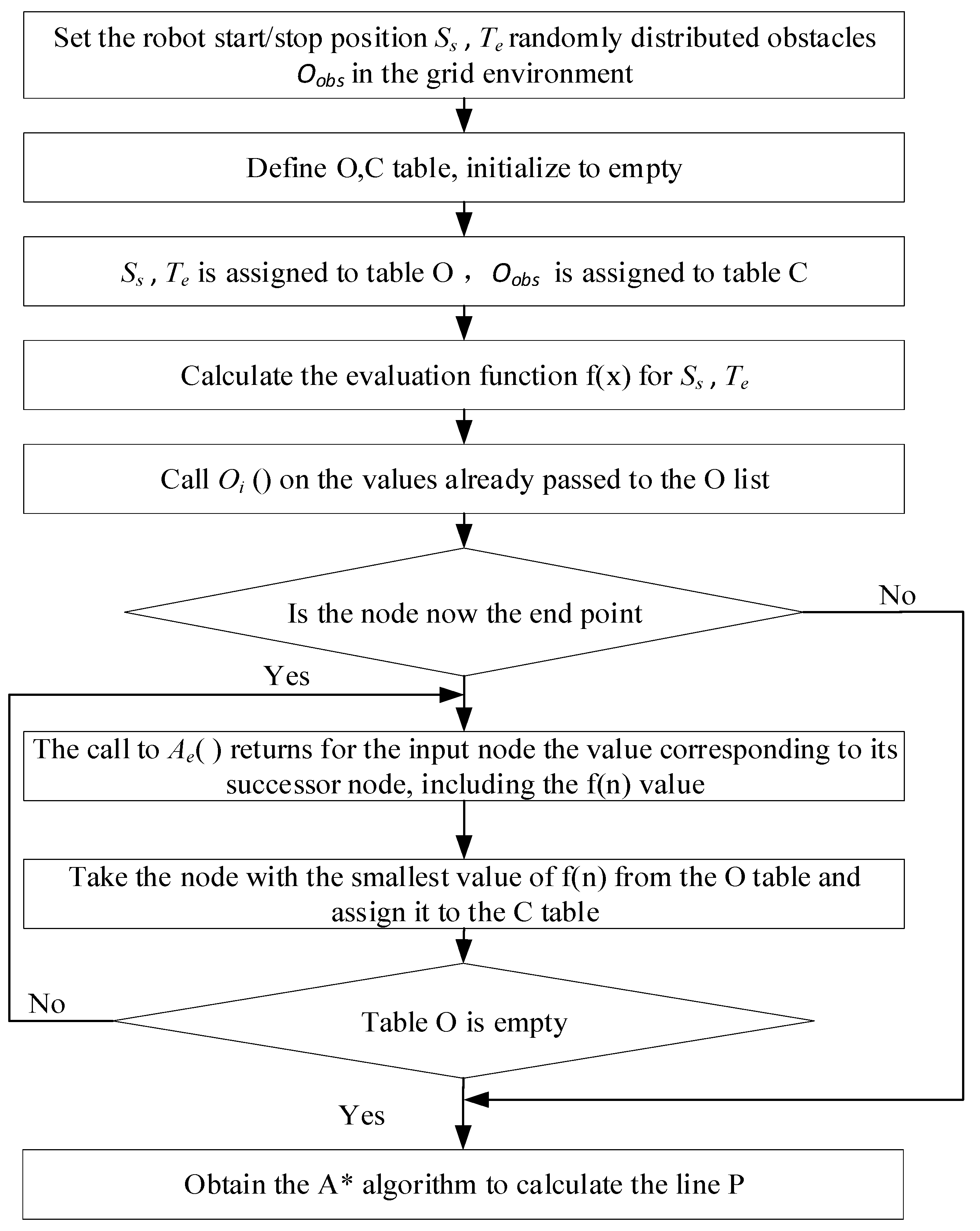
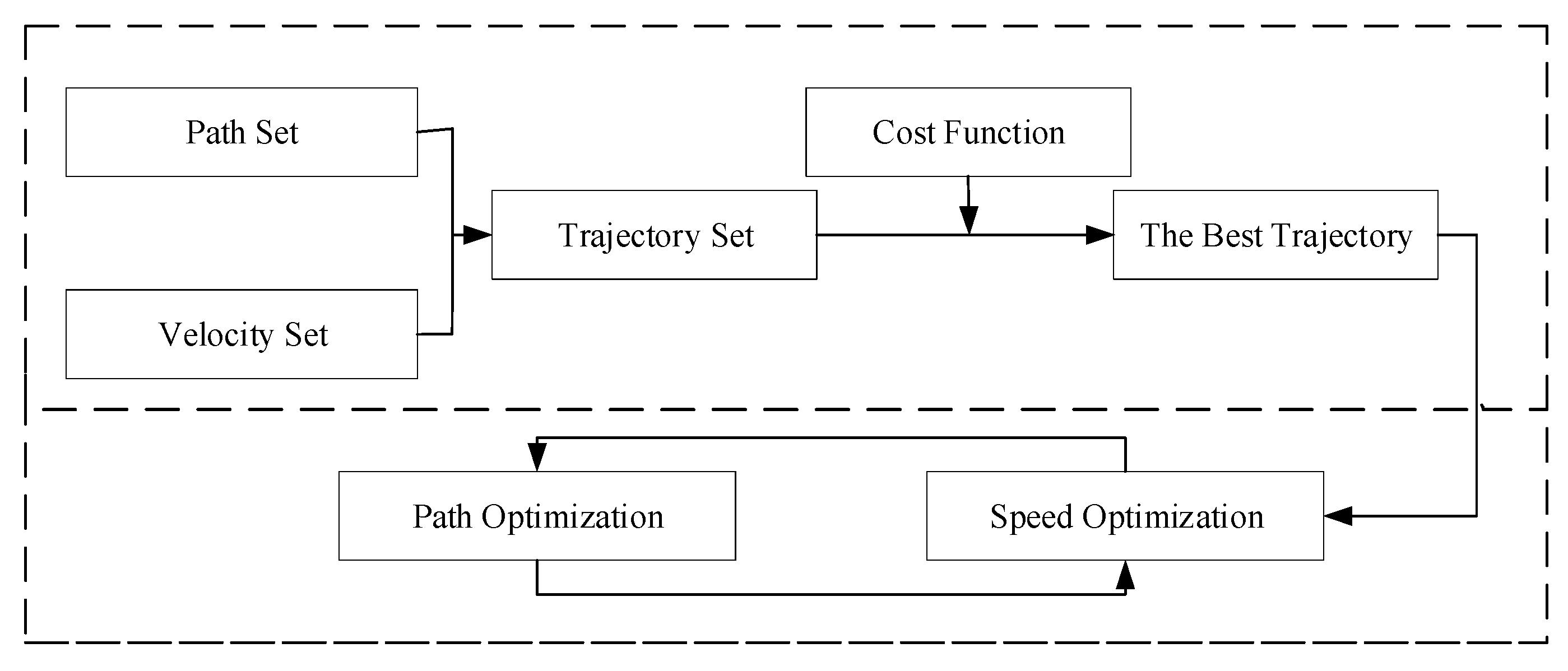
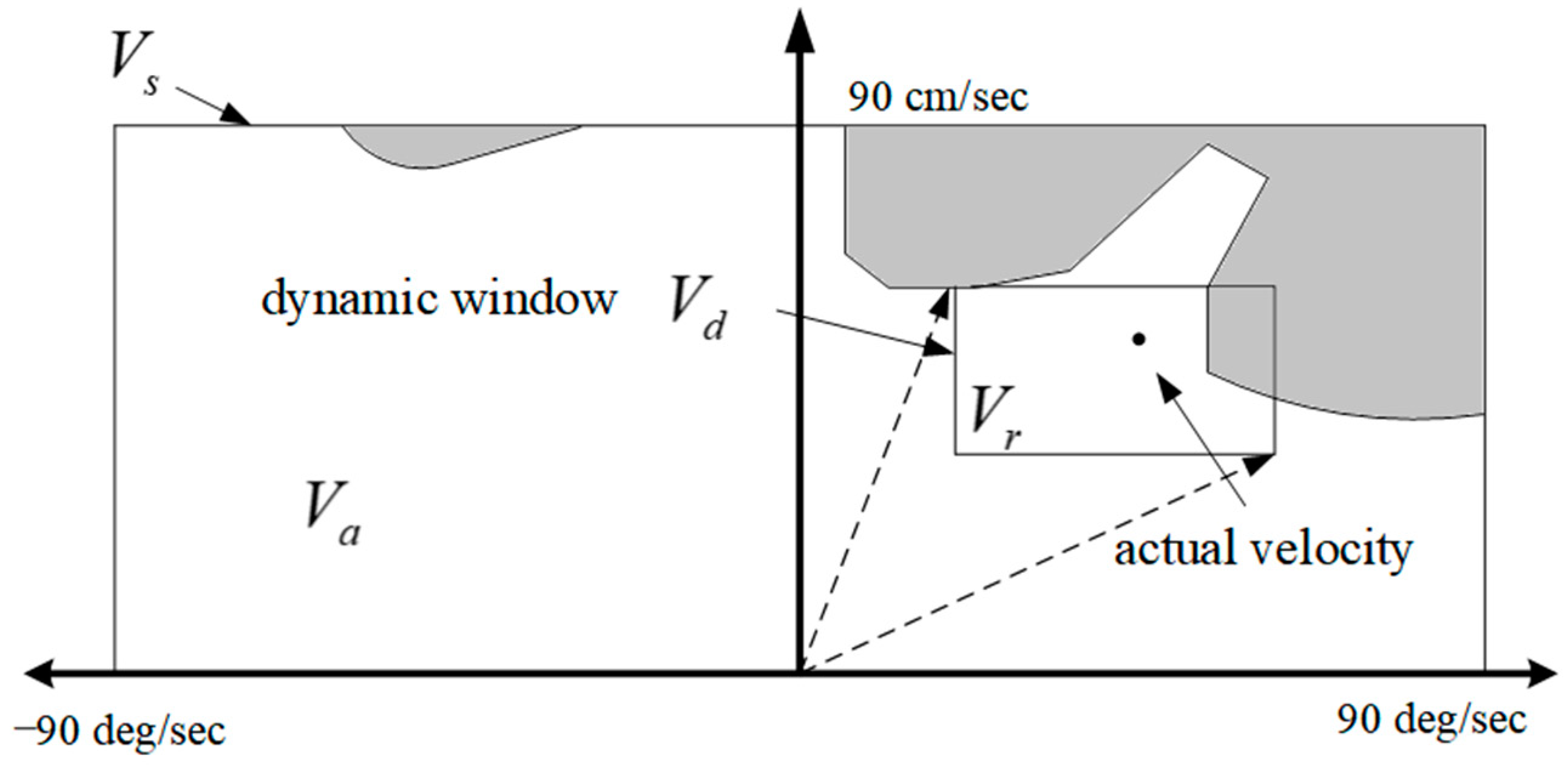
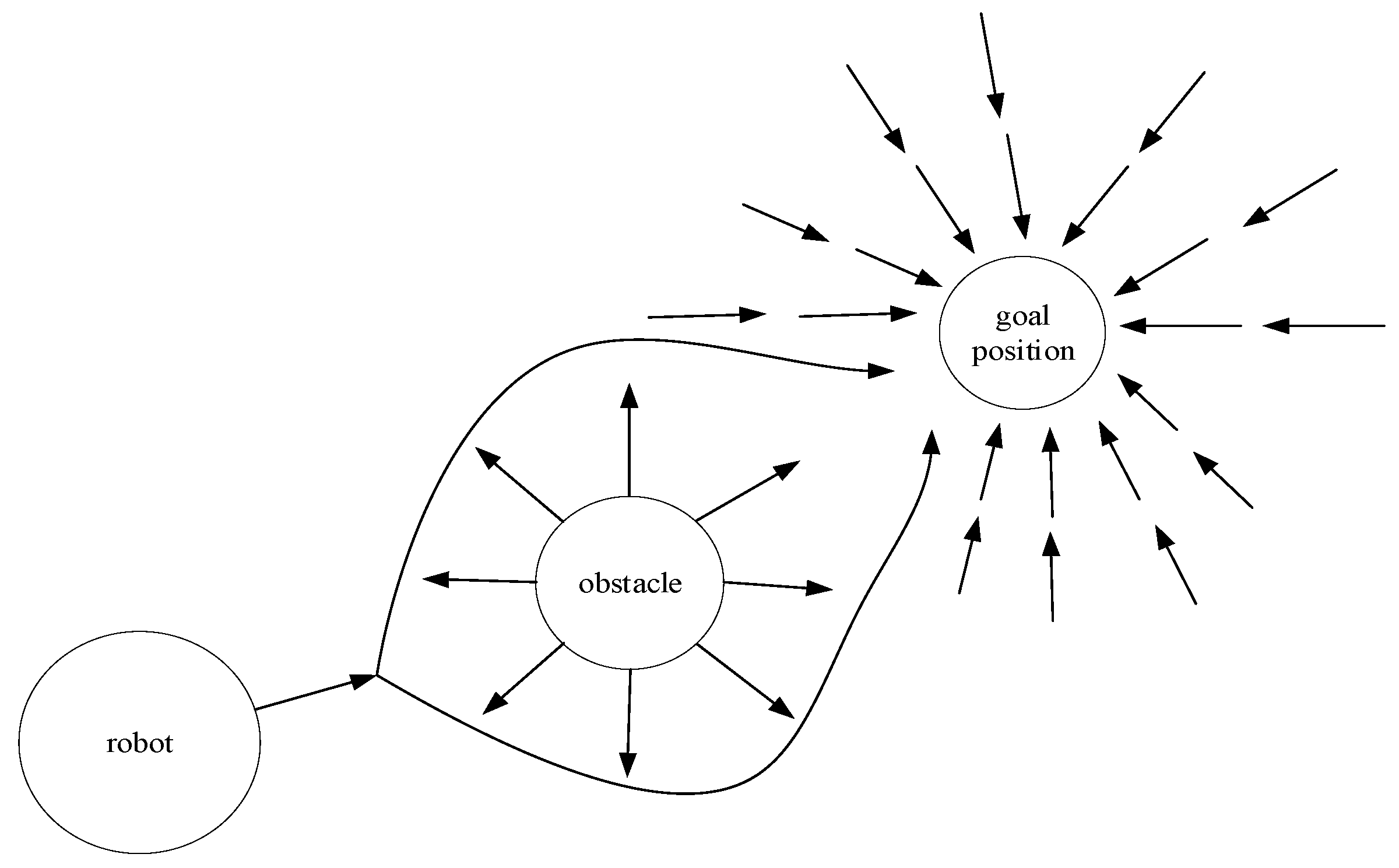


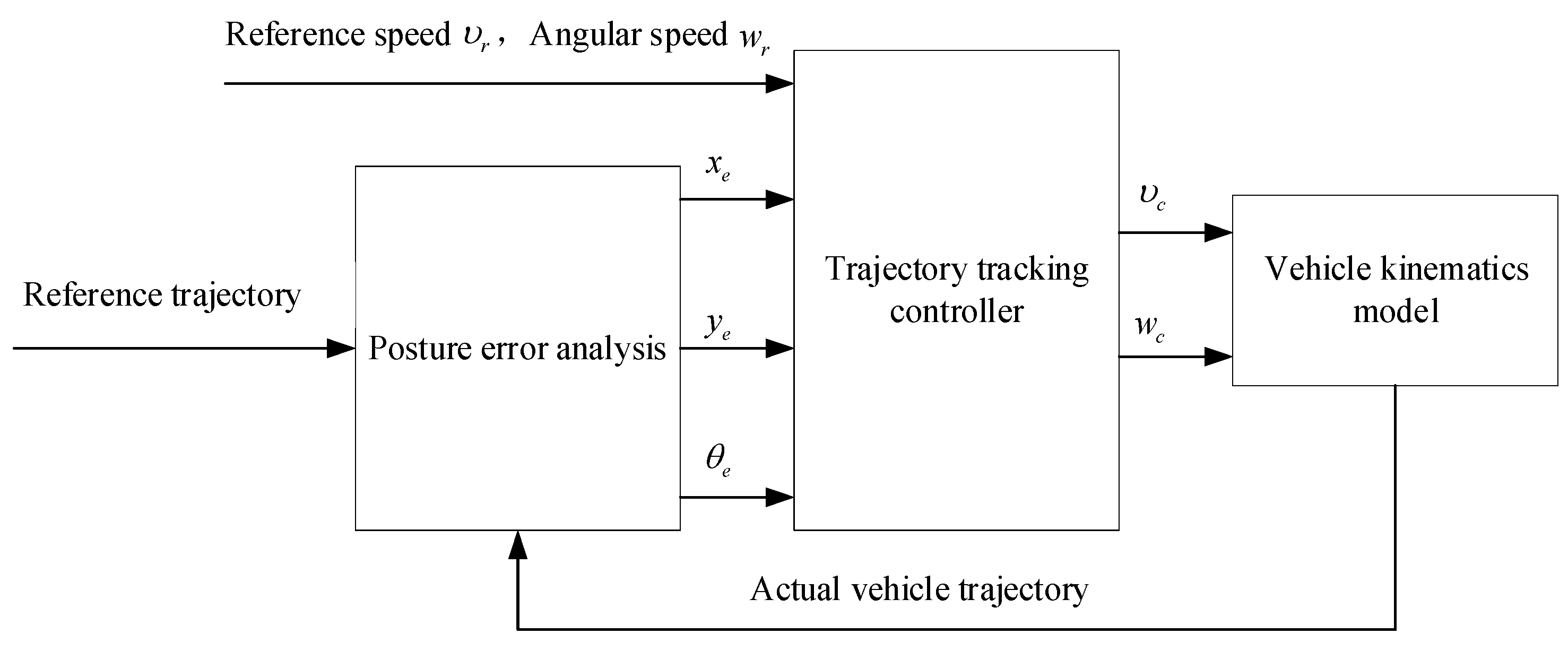
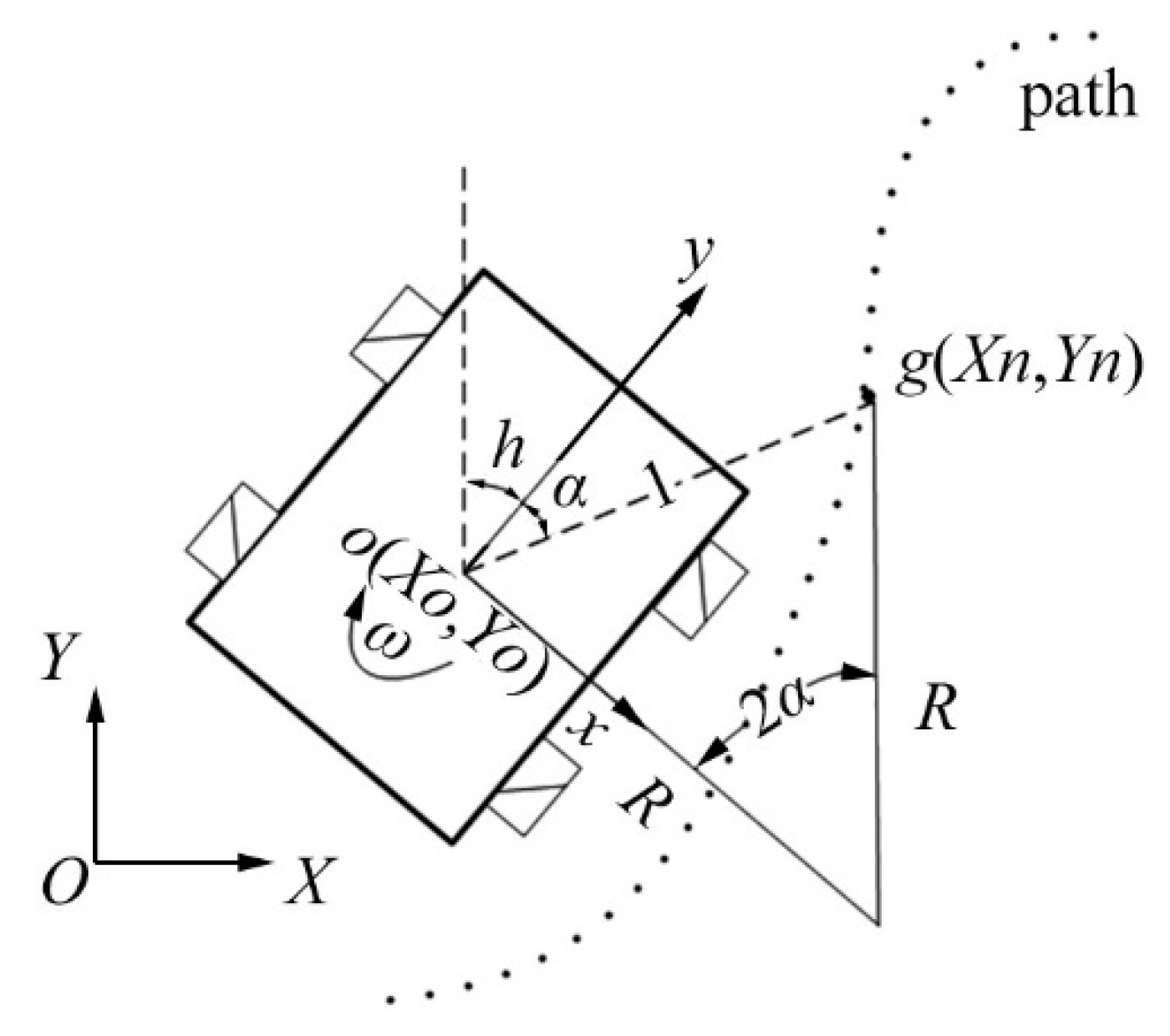

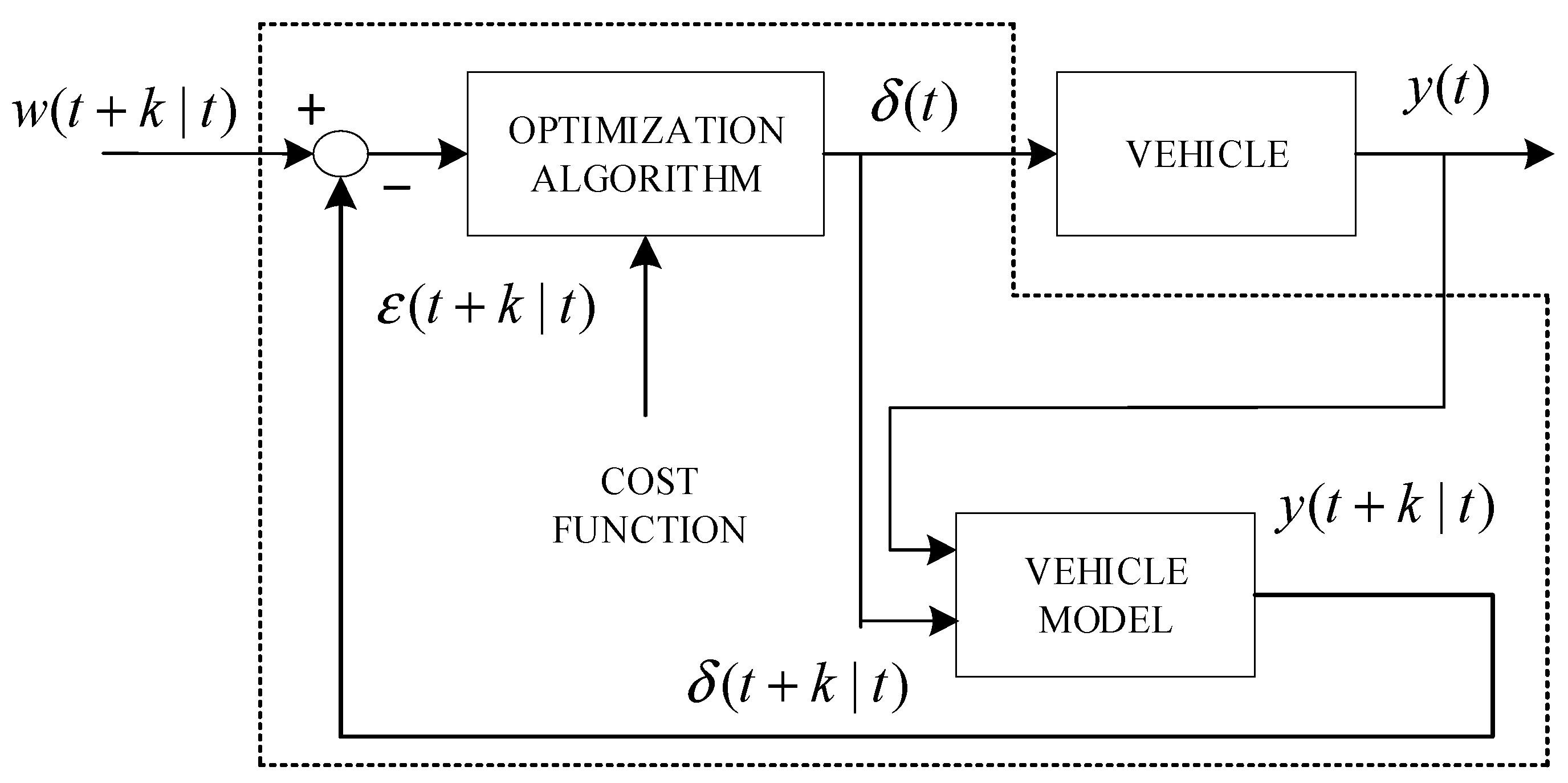
| Algorithms | Comments |
|---|---|
| Graph search algorithm | The amount of computation increases dramatically with increasing accuracy and is not suitable for application in complex environments. |
| Curve interpolation algorithm | Low computational cost and high real-time performance. |
| Sampling-based approach | The solution speed is fast, but the solution accuracy is not high. |
| Artificial potential field method | A relatively large advantage is path planning in uncertain dynamic environments, but it is easy to fall into local minima. |
| Machine learning methods | Fast computational speed and good generalization capability, but a large number of training samples are required. |
| Numerical optimization algorithms | More efficient solving, but real-time performance needs to be improved. |
| Algorithms | Comments |
|---|---|
| PID control | It has the advantages of easy implementation and high stability, but the parameters are difficult to optimize and the control performance is poor. |
| Robust control | It is highly resistant to interference, but it is difficult to achieve the optimal state. |
| Sliding mode control | It has a fast response, is insensitive to parameter changes and disturbances, and has simple and reliable control action. |
| Fuzzy control | It does not require precise system modelling and is fault-tolerant, but relies excessively on rule bases. |
| Pure pursuit control | It has better robustness but is sensitive to speed changes and prone to overshoot. |
| Linear quadratic regulator (LQR) control | It utilizes lower cost to obtain better control performance with high practicality, and it has better robustness against the effect of noise. |
| Model predictive control | It is easy to model, has better system robustness and stability, and can effectively deal with multivariate, constrained problems. |
Disclaimer/Publisher’s Note: The statements, opinions and data contained in all publications are solely those of the individual author(s) and contributor(s) and not of MDPI and/or the editor(s). MDPI and/or the editor(s) disclaim responsibility for any injury to people or property resulting from any ideas, methods, instructions or products referred to in the content. |
© 2023 by the authors. Licensee MDPI, Basel, Switzerland. This article is an open access article distributed under the terms and conditions of the Creative Commons Attribution (CC BY) license (https://creativecommons.org/licenses/by/4.0/).
Share and Cite
Song, X.; Gao, H.; Ding, T.; Gu, Y.; Liu, J.; Tian, K. A Review of the Motion Planning and Control Methods for Automated Vehicles. Sensors 2023, 23, 6140. https://doi.org/10.3390/s23136140
Song X, Gao H, Ding T, Gu Y, Liu J, Tian K. A Review of the Motion Planning and Control Methods for Automated Vehicles. Sensors. 2023; 23(13):6140. https://doi.org/10.3390/s23136140
Chicago/Turabian StyleSong, Xiaohua, Huihui Gao, Tian Ding, Yunfeng Gu, Jing Liu, and Kun Tian. 2023. "A Review of the Motion Planning and Control Methods for Automated Vehicles" Sensors 23, no. 13: 6140. https://doi.org/10.3390/s23136140
APA StyleSong, X., Gao, H., Ding, T., Gu, Y., Liu, J., & Tian, K. (2023). A Review of the Motion Planning and Control Methods for Automated Vehicles. Sensors, 23(13), 6140. https://doi.org/10.3390/s23136140







